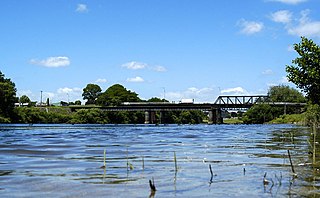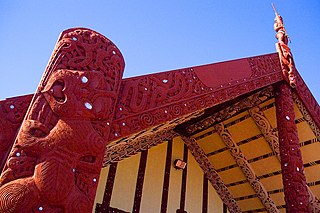
Ngaruawahia is a town in the Waikato region of the North Island of New Zealand. It is located 20 kilometres (12 mi) north-west of Hamilton at the confluence of the Waikato and Waipa Rivers, adjacent to the Hakarimata Range. Ngaruawahia lies within the Hamilton Urban Area, the fourth largest urban area in New Zealand. The location was once considered as a potential capital of New Zealand.

Otorohanga is a north King Country town in the Waikato region in the North Island of New Zealand. It is located 53 kilometres (33 mi) south of Hamilton and 18 kilometres (11 mi) north of Te Kuiti, on the Waipa River. It is a service town for the surrounding dairy-farming district. It is recognised as the "gateway" to the Waitomo Caves and as the "Kiwiana Town" of New Zealand. Until 2007, Otorohanga held a yearly 'Kiwiana Festival.'

Tūrangawaewae Marae is located in the town of Ngāruawāhia in the Waikato region of the North Island of New Zealand. A very significant marae, it is the headquarters for the Māori King Movement and the official residence and reception centre of the head of the Kīngitanga - currently the Māori King, Tuheitia Paki.

Dame Te Atairangikaahu was the Māori queen for 40 years, the longest reign of any Māori monarch. Her full name and title was Te Arikinui Dame Te Atairangikaahu. Her title Te Arikinui and name Te Atairangikaahu were bestowed when she became monarch; previously she was known as Princess Piki Mahuta and, after marriage, Princess Piki Paki.

The Māori King Movement, called the Kīngitanga or Kiingitanga in Māori, is a movement that arose among some of the Māori tribes of New Zealand in the central North Island in the 1850s, to establish a role similar in status to that of the monarch of the British colonists, as a way of halting the alienation of Māori land. The Māori monarch operates in a non-constitutional capacity with no legal or judicial power within the New Zealand government. Reigning monarchs retain the position of paramount chief of several tribes (iwi) and wield some power over these, especially within Tainui.

Pōtatau Te Wherowhero was a Māori warrior, leader of the Waikato iwi (tribes), the first Māori King and founder of the Te Wherowhero royal dynasty. He was first known just as Te Wherowhero and took the name Pōtatau after he became king in 1858. As disputes over land grew more severe Te Wherowhero found himself increasingly at odds with the Government and its policies.
Ngāti Mahuta is a sub-tribe of the Waikato tribe of Māori in the North Island of New Zealand. The territory (rohe) of Ngāti Mahuta is the Kāwhia and Huntly areas of the Waikato region.

Taupiri is a small town of about 450 people on the eastern bank of the Waikato River in the Waikato District of New Zealand. It is overlooked by Taupiri mountain, the sacred burial ground for the Waikato tribes of the Māori people, located just to the north.
Angus Hikairo Macfarlane, is a New Zealand, schoolteacher and educational psychologist. He has mixed Scottish and Māori ancestry, and was born in Rotorua into a family of 14 siblings. His family identify with Ko Te Arawa e waru pumanawa, the "eight beating hearts" of the Te Arawa tribe from the Bay of Plenty region in central North Island.

Waikato Rugby League is the local sporting body responsible for the administration of rugby league in the Waikato region of New Zealand. The WRL are represented by the Waikato rugby league team. They are currently part of the Upper Central Zone along with Coastline Rugby League and Bay of Plenty Rugby League.
Wiremu "Piri" Te Ranga Poutapu was a New Zealand Māori master carver and carpenter. He identified with the Ngāti Korokī and Waikato iwi. He was born in Maungatautari, Waikato, New Zealand in 1905. He was known as Piri, the Māori transliteration of Bill, short for William, of which his first name Wiremu is the Māori transliteration.
The 2016 New Zealand rugby league season was the 109th season of rugby league that had been played in New Zealand. The main feature of the year was the re-formatted National Competition, run by the New Zealand Rugby League. The competition was won by the Akarana Falcons.

The Kotahitanga movement was an autonomous Māori Parliament convened annually in New Zealand from 1892 until 1902. Though not recognised by the New Zealand Government, the Māori Parliament was an influential body while it lasted. By 1902 its role was largely superseded by the Māori Councils established by James Carroll and Hone Heke Ngapua through the Māori Councils Act 1900. As a result, Kotahitanga members unanimously voted for its dissolution at the 10th Parliament at Waiōmatatini in 1902.
Kelston Girls’ College (KGC) is a single-sex girls state secondary school in Kelston, a suburb in the Waitakere region of Auckland, New Zealand. It was created in 1963 when the roll of Kelston High School became too large for the site on the corner of Archibald and Great North Roads. The boys moved to a new site further down Archibald Road and the original site became the home of Kelston Girls’ High School.
Terina Lily Te Tamaki is a New Zealand rugby union player.

John Cornelius Moorfield, also known as Te Murumāra, was a New Zealand academic whose expertise was in the teaching of the Māori language. His work, including the publication of resources for learners of the language, contributed to the language's revitalisation.

Te Kohanga is a village and rural community in the Waikato District and Waikato Region of New Zealand's North Island. It is part of the Onewhero statistical area, which is much larger than this community. The meshblock covering Te Kohanga had a population of 102 in the 2013 New Zealand census.
Mere A Berryman is a New Zealand kaupapa Māori academic, are Māori, of Ngāi Tūhoe, Ngāti Awa, and Ngāti Whare descent and as of 2019 is a full professor at the University of Waikato.
Taiarahia Black is a New Zealand academic, who rose to a full professor at the Massey University. He is Māori, of Ngāi Tūhoe, Te Whānau a Apanui, Te Arawa, Ngāti Tūwharetoa and Ngāi Te Rangi descent.














